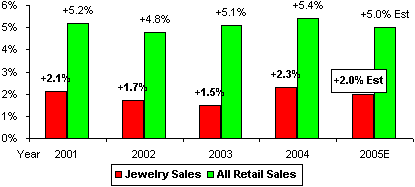IDEX Online Research: Modest Holiday Sales Gains Projected for Canadian Jewelers
November 03, 05
| +2% |
IDEX Online Research is also predicting that Canadian jewelers’ with free-standing units or with stores in strip shopping centers will out-perform their counterparts with jewelry stores located in shopping malls. For the past couple of years, Canadian shopping center sales have lagged, due to a decrease in customer traffic in malls. This reflects a similar trend in U.S. malls.
The graph below summarizes jewelers’ holiday sales trends (red bars) since 2001 as well as IDEX Online Research’s forecast for this year’s holiday season. The holiday sales forecast for all retail segments (green bars) was prepared by the International Council of Shopping Centers (ICSC).
| Canada - Holiday Sales Trends |
Canadian Holiday “Total Retail” Sales Projected +5 percent
The ICSC recently issued its forecast for Canadian holiday sales - +5 percent. According to the ICSC, this forecast can be characterized as a continuation of recent sales trends and a near-copy of the past several years.
Jewelry Holiday Sales to Show Modest Increase +2 percent
Though Canada is a major rough diamond producer (approximately 14 percent of global production), Canadians’ demand for diamond jewelry represents just under 2 percent of total global demand. Thus, it is not a major market for diamantaires. However, diamond and jewelry demand in Canada reflects seasonal trends similar to the U.S. In Canada, November-December jewelry sales represent about 28 percent of a jeweler’s annual sales; in the U.S., these two months represent about 33 percent of a jeweler’s yearly revenues.
Several factors are expected to have an impact on Canadian retail sales, including the following:
- Big-ticket demand has softened – The most important trend which has occurred in the Canadian market is a recent softening of demand for big-ticket durables such as autos, consumer electronics, and appliances. This trend could affect jewelry demand in the all-important holiday selling season.
- As the U.S. goes, so goes Canada – The Canadian economy is inextricably intertwined with its neighbor to the south – the United States. As key trading partners, fluctuations in the GDP of the U.S. – especially related to demand for Canadian-produced goods – are reflected in changes in Canada’s economic growth. However, consumer demand and retail sales are less cyclical in Canada than they are in the U.S.
- Inflation is up – Canadian consumer prices are up sharply due to soaring energy costs, though core inflation (excluding energy and food) remains a relatively tame 1.5-2.0 percent on an annualized basis.
- Energy prices are soaring – Like the U.S., Canadian consumers are paying more for their gasoline and heating oil. Thus, Canadians will have less discretionary income available to purchase luxury goods such as jewelry.
- Consumer confidence has rebounded – While there is no solid evidence that consumer confidence and retail sales correlate, it is notable that Canadian consumers apparently feel better about their future.
While Canadian total retail sales will likely be up about 5 percent in the holiday period, the ICSC is forecasting that consumer spending will be more price-driven than in prior years, especially given that inflation is eating away at shoppers’ purchasing power. IDEX Online Research believes that jewelers will see intensified price-based competition this year. The challenge for jewelry merchants will be to maintain profits in the face of modest sales gains.
